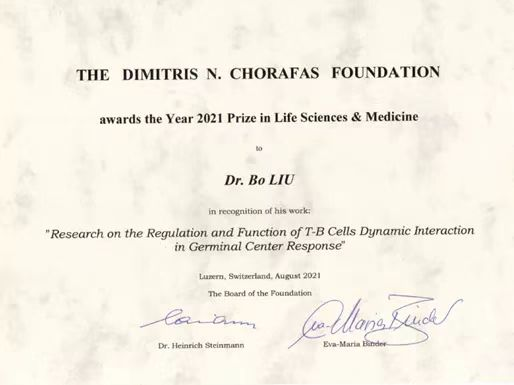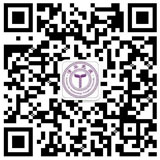The Dimitris N. Chorafas Foundation awards scientific prizes for outstanding work in selected fields in the engineering sciences, medicine and the natural sciences. It rewards research characterized by its high potential for practical application and by the special significance attached to its aftermath. Every year, partner universities in Europe, North America and Asia evaluate the research work of their graduating doctorate students and propose the best for prizing. Depending on the years of association with the Foundation and the size of the sample from which the best researcher is chosen (which must be statistically valid), some partner universities receive two prizes per year; others have one annual prize. The Foundation prizes the best doctoral student(s) in the Hard Sciences in each partner university.
The DIMITRIS N. CHORAFAS Foundation awards the Year 2021 Prize in Life Sciences & Medicine to Dr. Bo LIU in recognition of his work: “Research on the Regulation and Function of T-B Cells Dynamic Interaction in Germinal Centre Response.

Brief introduction of Dr. Bo LIU’s work:
The germinal center (GC) reaction supports antibody affinity maturation and gives rise to memory B cells and long-lived plasma cells. Affinity maturation critically depends on positive selection of rare clones that acquire higher-affinity B cell receptors via somatic hypermutation, present more antigen to follicular helper T (TFH) cells and, as a consequence, receive stronger contact-dependent T-cell help. As both TFH cells and GC B cells constantly migrate and do not maintain long-lasting physical contacts in the chaotic GC environment, it is unclear how sufficient T-cell help is cumulatively focused onto those rare cells through multiple interaction events across space and time. Here we show that, upon receipt of contact-dependent T-cell help in the form of CD40 ligand, GC B cells markedly upregulate chemokine CCL22 and to a lesser extent CCL17. By engaging CCR4 expressed on TFH cells, CCL22 and CCL17 can attract multiple helper cells at a distance to chase a migratory B cell, as observed by intravital imaging, increasing the chance of productive TFH interactions for the B cell. In a polyclonal GC response to protein immunization, B cells that acquire higher antigen-binding affinities express higher levels of CCL22. As revealed by a knock-in CCL22 reporter, increased levels of CCL22 expression highlight GC B cells with higher BCR affinities, while acute blockade of TFH help rapidly reduce CCL22 expression in higher-affinity B cells that otherwise produce more CCL22. These results establish a chemokine-based intercellular reaction circuit between the amount of T-cell help individual B cells recently receive and their subsequent abilities to attract more help. As a consequence, in the absence of CCL22 and CCL17 expression in B cells, GCs form but do not efficiently mature in affinity. When competing with wildtype B cells in the same reaction, individual B cells lacking CCL22 and CCL17 are disadvantaged in acquiring T-cell help to maintain GC participation or develop into bone-marrow plasma cells. By uncovering an affinity-coupled, chemokine-driven mechanism that permits dynamic highlighting of affinity-improved B cells for TFH cells to sense at a distance and thereby focuses available T-cell help onto these rare cells in a chaotic crowd of competitors, our study reveals a new principle of spatiotemporal orchestration of GC positive section.

Copyright © 2017 Institute for Immunology Tsinghua University
Contact Address: Room D302, Medical Science Building, Tsinghua University, Beijing 100084, China
Tel: (86) 10-62776420 Fax: (86) 10-62776420
